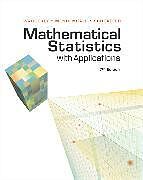Mathematical Statistics with Applications
Einband:
Fester Einband
EAN:
9780495110811
Untertitel:
Englisch
Genre:
Mathematik
Autor:
Dennis Wackerly, William Mendenhall, Richard Scheaffer
Herausgeber:
DUXBURY
Auflage:
07007 Auflage 7th edition
Anzahl Seiten:
944
Erscheinungsdatum:
01.10.2007
ISBN:
978-0-495-11081-1
Autorentext
The late Dr. Mendenhall served in the Navy in the Korean War and obtained a Ph.D. in Statistics at North Carolina State University. After receiving his Ph.D , he was a professor in the Mathematics Department at Bucknell University in Pennsylvania before moving to Gainesville in 1963 where he was the first chairman of the Department of Statistics at the University of Florida. Dr. Mendenhall published articles in some of the top statistics journals, such as Biometika and Technometrics; however, he is more widely known for his prolific textbook career. He authored or co-authored approximately 13 Statistics textbooks and several books about his childhood.Richard L. Scheaffer, Professor Emeritus of Statistics, University of Florida, received his Ph.D. in statistics from Florida State University. Accompanying a career of teaching, research and administration, Dr. Scheaffer has led efforts on the improvement of statistics education throughout the school and college curriculum. Co-author of five textbooks, he was one of the developers of the Quantitative Literacy Project that formed the basis of the data analysis strand in the curriculum standards of the National Council of Teachers of Mathematics. He also led the task force that developed the AP Statistics Program, for which he served as Chief Faculty Consultant. Dr. Scheaffer is a Fellow and past president of the American Statistical Association, a past chair of the Conference Board of the Mathematical Sciences, and an advisor on numerous statistics education projects.
Klappentext
In their bestselling title MATHEMATICAL STATISTICS WITH APPLICATIONS, premiere authors Dennis Wackerly, William Mendenhall, and Richard L. Scheaffer present a solid foundation in statistical theory while conveying the relevance and importance of the theory in solving practical problems in the real world. The authors' use of practical applications and excellent exercises helps you discover the nature of statistics and understand its essential role in scientific research. With the addition of contributor Brendan Ames, MATHEMATICAL STATISTICS WITH APPLICATIONS now includes an enhanced eTextbook. Simulation activities using interactive applets and R embedded within the MindTap Reader help students visualize statistical concepts, and an appendix introducing students to statistical data analysis using R can be found at the end of the eTextbook.
Inhalt
1. What Is Statistics? Introduction. Characterizing a Set of Measurements: Graphical Methods. Characterizing a Set of Measurements: Numerical Methods. How Inferences Are Made. Theory and Reality. Summary. 2. Probability. Introduction. Probability and Inference. A Review of Set Notation. A Probabilistic Model for an Experiment: The Discrete Case. Calculating the Probability of an Event: The Sample-Point Method. Tools for Counting Sample Points. Conditional Probability and the Independence of Events. Two Laws of Probability. Calculating the Probability of an Event: The Event-Composition Methods. The Law of Total Probability and Bayes''''s Rule. Numerical Events and Random Variables. Random Sampling. Summary. 3. Discrete Random Variables and Their Probability Distributions. Basic Definition. The Probability Distribution for Discrete Random Variable. The Expected Value of Random Variable or a Function of Random Variable. The Binomial Probability Distribution. The Geometric Probability Distribution. The Negative Binomial Probability Distribution (Optional). The Hypergeometric Probability Distribution. Moments and Moment-Generating Functions. Probability-Generating Functions (Optional). Tchebysheff''''s Theorem. Summary. 4. Continuous Random Variables and Their Probability Distributions. Introduction. The Probability Distribution for Continuous Random Variable. The Expected Value for Continuous Random Variable. The Uniform Probability Distribution. The Normal Probability Distribution. The Gamma Probability Distribution. The Beta Probability Distribution. Some General Comments. Other Expected Values. Tchebysheff''''s Theorem. Expectations of Discontinuous Functions and Mixed Probability Distributions (Optional). Summary. 5. Multivariate Probability Distributions. Introduction. Bivariate and Multivariate Probability Distributions. Independent Random Variables. The Expected Value of a Function of Random Variables. Special Theorems. The Covariance of Two Random Variables. The Expected Value and Variance of Linear Functions of Random Variables. The Multinomial Probability Distribution. The Bivariate Normal Distribution (Optional). Conditional Expectations. Summary. 6. Functions of Random Variables. Introductions. Finding the Probability Distribution of a Function of Random Variables. The Method of Distribution Functions. The Methods of Transformations. Multivariable Transformations Using Jacobians. Order Statistics. Summary. 7. Sampling Distributions and the Central Limit Theorem. Introduction. Sampling Distributions Related to the Normal Distribution. The Central Limit Theorem. A Proof of the Central Limit Theorem (Optional). The Normal Approximation to the Binomial Distributions. Summary. 8. Estimation. Introduction. The Bias and Mean Square Error of Point Estimators. Some Common Unbiased Point Estimators. Evaluating the Goodness of Point Estimator. Confidence Intervals. Large-Sample Confidence Intervals Selecting the Sample Size. Small-Sample Confidence Intervals for u and u1-u2. Confidence Intervals for o2. Summary. 9. Properties of Point Estimators and Methods of Estimation. Introduction. Relative Efficiency. Consistency. Sufficiency. The Rao-Blackwell Theorem and Minimum-Variance Unbiased Estimation. The Method of Moments. The Method of Maximum Likelihood. Some Large-Sample Properties of MLEs (Optional). Summary. 10. Hypothesis Testing. Introduction. Elements of a Statistical Test. Common Large-Sample Tests. Calculating Type II Error Probabilities and Finding the Sample Size for the Z Test. Relationships Between Hypothesis Testing Procedures and Confidence Intervals. Another Way to Report the Results of a Statistical Test: Attained Significance Levels or p-Values. Some Comments on the Theory of Hypothesis Testing. Small-Sample Hypothesis Testing for u and u1-u2. Testing Hypotheses Concerning Variances. Power of Test and the Neyman-Pearson Lemma. Likelihood Ration Test. Summary. 11. Linear Models and Estimation by Least Squares. Int

Leider konnten wir für diesen Artikel keine Preise ermitteln ...
billigbuch.ch sucht jetzt für Sie die besten Angebote ...
Die aktuellen Verkaufspreise von 6 Onlineshops werden in Realtime abgefragt.
Sie können das gewünschte Produkt anschliessend direkt beim Anbieter Ihrer Wahl bestellen.
Loading...
Die aktuellen Verkaufspreise von 6 Onlineshops werden in Realtime abgefragt.
Sie können das gewünschte Produkt anschliessend direkt beim Anbieter Ihrer Wahl bestellen.
| # | Onlineshop | Preis CHF | Versand CHF | Total CHF | ||
|---|---|---|---|---|---|---|
| 1 | Seller | 0.00 | 0.00 | 0.00 |
